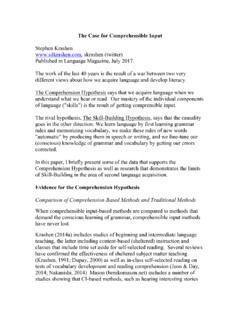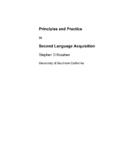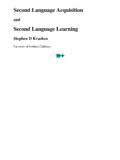Transcription of The comprehension hyp extended - Stephen Krashen
1 The comprehension Hypothesis extended Stephen Krashen In T. Piske and M. Young-Scholten (Eds.) Input Matters in SLA. Bristol: Multilingual Matters. pp. 81-94. In this paper I review the evidence for the comprehension Hypothesis in oral language and literacy, and discuss the possibility that the comprehension Hypothesis provides a plausible explanation for non-human language acquisition. The clearest data comes from several areas of research in animal language but we will also briefly consider what some of the possibilities are for other non-human species. The comprehension Hypothesis The comprehension Hypothesis states that we acquire language and develop literacy when we understand messages, that is, when we understand what we hear and what we read, when we receive comprehensible input ( Krashen , 2003). Language acquisition is a subconscious process; while it is happening we are not aware that it is happening, and the competence developed this way is stored in the brain subconsciously.
2 Studies have shown that several affective variables are related to success in language acquisition anxiety (low anxiety is correlated with more success in language acquisition), self-esteem (more self-esteem is related to success in language acquisition), and motivation, with integrative motivation, (a desire to belong to a certain group) related to long-term success in language acquisition (until membership is achieved), and instrumental motivation (to accomplish a task) related to shorter term success (until the task is done). To relate affective variables to the comprehension Hypothesis, it has been hypothesized that for input to enter the language acquisition device the acquirer must be open to the input: the affective filter must be low, or down. This view considers affective barriers to be outside the language acquisition device, a hypothesis that predicts that affective factors will not influence the nature of acquisition or the order of acquisition of the parts of language ( Krashen , 1982, 2003).
3 Smith (1988) hypothesizes that for language acquisition to take place, the acquirer must consider himself or herself to be a potential member of the club of those who speak the language. It is easy to translate this idea into the affective filter framework: When integrative motivation (Gardner and Lambert, 1972) is high and anxiety is low, the affective filter is lowered, and those late-acquired aspects of language that mark club membership are acquired. Club membership explains why we do not always acquire all varieties of language we are exposed to, why, for example, older children prefer the language of peers over the language of their parents. The comprehension Hypothesis has had several inventors and has been known by several different names. I have referred to it as the Input Hypothesis in previous publications. Well before my work began, Frank Smith and Kenneth Goodman have hypothesized that we learn to read by reading, by understanding what is on the page ( Smith, 2004; Goodman and Goodman, 1979).
4 James Asher (Asher, 2000) and Harris Winitz (Winitz, 1981) among 2 others, also hypothesized that comprehension is the mechanism underlying language acquisition in publications that predate mine. output Hypotheses The chief rivals of the comprehension Hypothesis are two kinds of output plus feedback hypotheses. The Skill-Building Hypothesis maintains that we acquire language when we consciously learn rules of grammar and vocabulary, and we learn to read by first consciously learning the rules of phonics. output helps us by making our knowledge more automatic through practice and by providing a domain for error correction, which helps us arrive at a better version of our rule. This approach is also known as direct teaching or formal instruction. The Comprehensible output Hypothesis maintains that language acquisition occurs when we say something and our conversational partner does not understand, forcing us to notice a gap in our competence.
5 We then try again until we arrive at the correct version of the rule. The evidence reviewed here and elsewhere (references to follow) strongly supports the comprehension Hypothesis for both literacy and language development, and the evidence for both is similar. Direct Confrontations We first examine direct confrontations, studies in which comprehension -based methods are compared with methods based on rival hypotheses. Experimental Studies For second language acquisition at beginning stages, comprehensible-input based methods such as Total Physical Response and Natural Approach have been shown to be more effective than skill-building based methods (for reviews, see Krashen , 1982, 1994, 2003). For beginning literacy development in the first language, students in classes in which more real reading is done outperform those in classes in which less reading is done ( Krashen , 2002a).
6 The results at the intermediate level are similar. In second language development, comprehensible subject matter teaching in the second language, known as sheltered subject matter teaching, has been shown to be as or more effective as traditional intermediate instruction for literate, intermediate level foreign language students (research reviewed in Krashen , 1991). In both first and second language development, students who participate in classes that include in-school self-selected reading programs (known as sustained silent reading) typically outperform comparison students, especially when the duration of treatment is longer than an academic year (reviews include Krashen , 2003, 2004, 2005). 3 Correlational Studies Crucial correlational studies are those that compare the comprehension Hypothesis with competing hypotheses, using multivariate methods. Using multiple regression, Gradman and Hanania (1991) reported that extracurricular reading was a strong and significant predictor of performance on the TOEFL examination for international students taking the test abroad.
7 Extremely problematic for output hypotheses was the result that the amount of extracurricular writing and extracurricular speaking reported were negatively related to TOEFL performance. Lee (2005) examined predictors of writing performance of university students studying English as a foreign language in Taiwan. The results of a structural equation model analysis revealed that the amount of free reading students reported doing was a significant predictor of writing performance, but the amount of free writing done was not. Also, students with a stronger belief in the efficacy of reading and writing instruction did not do better on the writing test. The Effect of Applications of Rival Hypotheses Increasing comprehensible input clearly results in more language acquisition and more literacy development; we consistently see positive correlations between the amount of reading done and progress in reading, as well as the amount of aural comprehensible input received and language development ( Krashen , 1982, 1988a, 2003).
8 But adding more direct instruction or output either does not result in more development or results in only very modest improvement. When improvement occurs, it occurs just where the Monitor hypothesis predicts it will. Direct Instruction: Grammar Studies done over the last century have failed to find a significant effect for the teaching of grammar on the reading and writing of native speakers of English (for reviews, see Krashen , 1984; Hillocks, 1986). In the field of second language acquisition, a parade of studies done in the last decade has attempted to demonstrate that grammar instruction is beneficial. Truscott (1998) and Krashen (2003) have reviewed many of these studies and conclude that they only demonstrate that grammar study has a very limited effect: The subjects used in these studies are students who are familiar with grammar study and who generally accept the claim that grammar study is useful.
9 Yet, after a considerable amount of study, gains are typically very modest, are demonstrated only on tests in which there is a clear focus on form, and typically fade with time. These results are consistent with the Monitor Hypothesis: Consciously learned grammar is only available as a Monitor or an editor, and the constraints on Monitor use are severe: The 4 user has to know the rule (see the complexity argument below), have time to apply the rule, and be thinking about correctness ( Krashen , 1982, 2003). Direct Instruction: Vocabulary A few studies of direct instruction of vocabulary seem to have produced what appear to be remarkable results (Nation, 2001, p. 298). But the advantage of these methods is only apparent. As argued in Krashen (1989), vocabulary teaching methods that appear to be very efficient do not provide a deep knowledge of words, with their full semantic and syntactic properties, generally providing only synonyms or short definitions.
10 Direct Instruction: Spelling There is good evidence that direct instruction in spelling has limited effects ( Krashen , 1989). Here are some samples of this research. Over one hundred years ago, Rice (1897) reported no relationship between the amount of time devoted to spelling and spelling achievement, when measured on tests involving words in sentences and compositions. Cook (1912) tested high school and college students who had just completed a semester of intensive study of spelling rules. There was no difference in spelling accuracy among those who said they knew the rules and used them, those who said they knew the rules and did not use them, and those who said they did not know the rules. As we will see later, Cook also reported that few students really knew the rules. More recent confirmation comes from Wilde (1990), who estimated that each spelling word learned through direct instruction takes about 20 minutes of instructional time.














